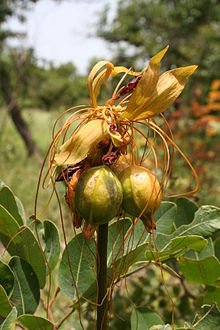Tacca leontopetaloides

Tacca leontopetaloides is a species of flowering plant in the yam family Dioscoreaceae. It is native to Island Southeast Asia but have been introduced as canoe plants throughout the Indo-Pacific tropics by Austronesian peoples during prehistoric times. They have become naturalized to tropical Africa, South Asia, northern Australia, and Oceania.[1] Common names include Polynesian arrowroot, Fiji arrowroot, East Indies arrowroot, and pia.[3]
Polynesian arrowroot is an ancient Austronesian root crop closely related to yams. It is originally native to Island Southeast Asia. It was introduced throughout the entire range of the Austronesian expansion during prehistoric times (c. 5,000 BP), including Micronesia, Polynesia, and Madagascar. Polynesian arrowroot have been identified as among the cultivated crops in Lapita sites in Palau, dating back to 3,000 to 2,000 BP.[4] It was also introduced to Sri Lanka, southern India, and possibly also Australia through trade and contact.[5]
Polynesian arrowroot was a minor staple among Austronesians. The roots are bitter if not prepared properly, thus it was only cultivated as a secondary crop to staples like Dioscorea alata and Colocasia esculenta. Its importance increased for settlers in the Pacific Islands, where food plants were scarcer, and it was introduced to virtually all the inhabited islands. They were valued for their ability to grow in low islands and atolls, and were often the staple crops in islands with these conditions. In larger islands, they were usually allowed to grow feral and were useful only as famine food. Several cultivars have been developed in Polynesia due to the centuries of artificial selection. The starch extracted from the root with traditional methods can last for a very long time, and thus can be stored or traded.[4] The starch can be cooked in leaves to make starchy puddings, similar to the use of starch extracted from sago palms (Metroxylon sagu).[6] Due to the introduction of modern crops, it is rarely cultivated today.[4]
